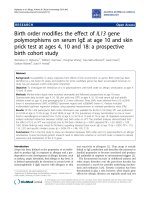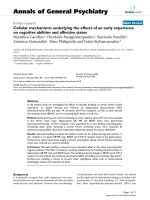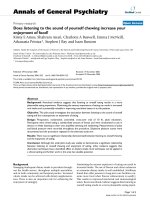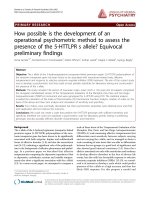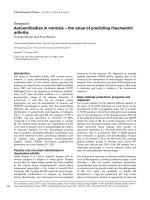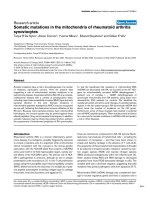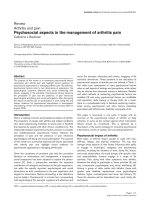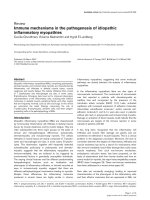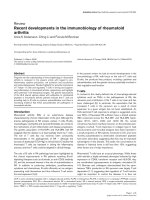Báo cáo y học: "HLA-DR regulation and the influence of GM-CSF on transcription, surface expression and shedding
Bạn đang xem bản rút gọn của tài liệu. Xem và tải ngay bản đầy đủ của tài liệu tại đây (504.08 KB, 11 trang )
Int. J. Med. Sci. 2004 1(3): 126-136
126
International Journal of Medical Sciences
ISSN 1449-1907 www.medsci.org 2004 1(3):126-136
©2004 Ivyspring International Publisher. All rights reserved
HLA-DR regulation and the influence of GM-CSF on
transcription, surface expression and shedding
Research paper
Received: 2004.4.16
Accepted: 2004.6.10
Published:2004.7.10
Sara E Perry
1
, Sobhy M Mostafa
2
, Richard Wenstone
2
, Alan Shenkin
3
, Paul J
McLaughlin
1
1. Department of Immunology, University of Liverpool, Liverpool, UK.
2. Intensive Care Unit, Royal Liverpool University Hospital, Liverpool, UK.
3. Department of Clinical Chemistry, University of Liverpool, Liverpool, UK.
A
A
b
b
s
s
t
t
r
r
a
a
c
c
t
t
Low surface HLA-DR expression is a feature in sepsis. However, the mechanisms
that regulate HLA-DR expression have not been elucidated. The current study
investigates regulation of HLA-DR gene transcription, post transcriptional
events and shedding of surface HLA-DR, as well as the regulation of HLA-DR by
GM-CSF and an immunomodulatory cytokine. Plasma and PBMC were collected
from septic patients and healthy volunteers. An ELISA was developed to measure
soluble HLA. PCR techniques were used to determine HLA-DR mRNA levels,
and flow cytometry and fluorescent microscopy were used for measurement of
surface expressed and intracellular HLA-DR. Septic patients fulfilling the criteria
of the American College of Chest Physicians (ACCP) for sepsis were recruited for
the study (n=70). HLA-DR was measured on three consecutive days, days seven
and fourteen. Patients were excluded from the study if on immunosuppressive
therapy. Results: Higher levels of shed HLA-DR were found in the plasma of
septic patients compared to healthy controls. The level of HLA-DR mRNA was
significantly lower in septic patients compared to healthy controls, however an
increased intracellular HLA-DR expression was observed. When HL-60 cells
were treated with GM-CSF, gene transcription, surface expression and shedding
of HLA-DR were all up-regulated. These results indicate that the mechanisms
involved in the regulation of HLA-DR in sepsis include shedding of HLA-DR
from the cell surface and regulation of HLA-DR gene transcription. Post-
translational processing of HLA-DR was also seen to be compromised. GM-CSF
was shown to regulate HLA-DR at all these levels.
K
K
e
e
y
y
w
w
o
o
r
r
d
d
s
s
Sepsis, HLA-DR, monocyte, GM-CSF, post translational
A
A
u
u
t
t
h
h
o
o
r
r
b
b
i
i
o
o
g
g
r
r
a
a
p
p
h
h
y
y
Sara Perry obtained her BSc in Microbiology and Immunology from University of
Leeds, and PhD in Immunology from University of Liverpool, where she worked on the
expression of HLA-DR and the characterisation of the monocyte in patients with sepsis.
She is currently a Research Fellow at University of Leeds working on Immunotherepy
for colorectal cancer.
…Continued at the end of paper.
C
C
o
o
r
r
r
r
e
e
s
s
p
p
o
o
n
n
d
d
i
i
n
n
g
g
a
a
d
d
d
d
r
r
e
e
s
s
s
s
Paul J McLaughlin, Department of Immunology, University of Liverpool, Duncan
Building, Daulby Street, Liverpool, L69 3GA. Email:
, Tel
No: 0113 3433130.
Int. J. Med. Sci. 2004 1(3): 126-136
127
1. Introduction
Impaired monocyte function has been described in sepsis and has been characterised by inadequate
respiratory burst, activation, antigen presentation and lowered expression of Human Leukocyte
Antigen-DR (HLA-DR) [1;2]. HLA-DR is a glycosylated cell surface transmembrane protein expressed
on antigen-presenting cells and constitutively expressed on monocytes. Expression of HLA-DR by
monocytes is essential for the presentation of peptides derived from ingested microbes to CD4 positive
T cells to initiate a specific immune response [3]. Low monocyte surface expression of HLA-DR is a
feature of sepsis [3-8], however the mechanisms for this reduced surface expression of HLA-DR have
not been established. Possibilities include down regulation of gene transcription resulting in reduced
mRNA production, and/or post-translational modification of HLA-DR affecting processing to the cell
surface. Alternatively, HLA-DR could be cleaved from the monocyte surface and shed into the
circulation in a soluble form. Higher levels of soluble HLA-DR (sHLA-DR) have been detected in
plasma and synovial fluid in hyperinflammatory states [9] and in vitro experiments have shown that the
inflammatory cytokine IFN-γ induced shedding of HLA-DR by human monocytes [10]. However
whether this type of mechanism is responsible for depressed monocyte HLA-DR in sepsis is not
established, as one report found plasma HLA-DR to be lower rather than raised in septic patients who
had a down regulated surface expression [11]. Recently, the regulation of HLA-DR at the level of gene
transcription has been investigated in patients with sepsis, this correlated with high cortisol levels and
was thought to be acting on the down regulation of HLA-DR mRNA by also lowering the CIITA [12]
IFN-γ has also been shown to regulate transcription of the HLA-DR gene on melanoma cell lines [13].
Recently a post-translational modification of HLA-DR was described in septic patients which may be
responsible for the lowered monocyte surface expression of HLA-DR observed in these septic patients
[14].
Lowered HLA-DR expression has been associated with impaired monocyte function and restoring
expression to normal levels has been proposed to be beneficial [3]. A candidate factor for activating
monocytes and restoring functional indicators is granulocyte macrophage colony stimulating factor
(GM-CSF). GM-CSF is a 22-kDa glycoprotein cytokine secreted by mononuclear leukocytes including
monocytes. It functions as a growth and differentiation factor for immature phagocytic cells and
clinically it is used to enhance reconstitution of the haemopoietic system, for example following
chemotherapy [15]. In addition to this, GM-CSF has been demonstrated to enhance the capability of
monocytes and macrophages to phagocytose invading pathogens [16]. GM-CSF treatment of septic
patients’ lymphocytes ex vivo has been shown to restore function in anergic monocytes [2]. It has been
shown that GM-CSF induces monocyte activation [17] and can protect monocytes from becoming
apoptotic [2]. Clinically, recombinant human GM-CSF has been shown to be effective in the treatment
of neonatal sepsis [18] with neutropenia [19]
We have previously shown that monocyte HLA-DR surface expression was upregulated in short
term culture with GM-CSF and that low plasma levels of GM-CSF were an indicator of poor prognosis
in sepsis [20]. In the present study we have investigated whether GM-CSF could be a factor in
regulating HLA-DR expression in PBMC from patients with sepsis.
2. Methods
Patient Selection
Ethical approval for the study was obtained from the Liverpool Research Ethics Committee. This
was a single centre study at a medico-surgical adult Intensive Care Unit (ICU) of the Royal Liverpool
University Hospital. All critically ill septic patients admitted to the ICU who were recruited were
expected to stay in the ICU for at least 72 hours, not expected to die within 24 hours and fulfilled the
consensus conference criteria for sepsis [21]. Assent was obtained from next of kin if patients
themselves were unable to consent into the study. Patients were excluded from the study if any of the
following criteria were applicable: patients who were septic for greater than 72h; patients who were
immunosuppressed due to prednisolone therapy >5 mg per day or equivalent, (excluding inhaled
steroids); patients with clinically suspected or confirmed acquired immunodeficiency syndrome,
hepatitis B or C; granulocyte count less than 1000 per mm
3
due to a cause other than severe sepsis. Also
patients with an underlying medical condition, exclusive of septic shock which was expected to cause
Int. J. Med. Sci. 2004 1(3): 126-136
128
death within three months from study entry were excluded. Healthy volunteers (n=45) were included as
controls. The control group consisted of laboratory staff, median age 32. Mortality and focus of sepsis
are described in the previous study [22].
Sample preparation and flow cytometry
Arterial blood was collected from septic patients on the day sepsis was diagnosed (day 0) and on
days 3, 7, and 14 for PCR studies and days 0, 1, and 2 for measurement of soluble HLA-DR. Blood (7.5
ml) was collected in preservative free heparin (final concentration of 100 iu/ml) and cells were prepared
immediately. PBMC were isolated by density centrifugation using Ficoll Paque (Pharmacia Biotech,
Sweden). Briefly, whole blood was layered onto an equal volume of Ficoll and centrifuged at 400xg for
20 minutes at 18˚C. Following isolation and washing of the PBMC viability was assessed to greater
than 95% using trypan blue exclusion and the PBMC were adjusted to a concentration of 1x10
6
PBMC/ml.
Flow cytometric analysis was carried out on Coulter Epics Flow Cytometer. PBMC were dual-
labelled with a mouse IgG anti-human HLA-DR with a fluorescein isothiocyanate (FITC) conjugate,
clone L243 (Becton Dickinson, UK) and with a mouse IgG anti-human CD14 R-phycoerythrin
conjugate (R-PE), clone M5E2, (Becton Dickinson, UK) to identify monocytes. Briefly 100 µl of cells
were incubated with 5 µl of neat antibody for 30 minutes at 4˚C in the dark, washed and resuspended in
0.5 ml of PBS. For intracellular measurement of HLA-DR the PBMC were fixed for 10 minutes in 1%
paraformaldhyde, washed in PBS and then incubated in saponin buffer (0.04% EGTA; 0.02% NaN
3
;
1% heat inactivated FCS; 0.1% saponin in PBS) before incubation with antibody as above. [All
products from Sigma, UK unless mentioned otherwise]. Both the percentage of cells expressing HLA-
DR on monocytes and the density of HLA-DR was measured.
Immuno-fluorescent microscopy of HLA-DR in PBMC
Cytospins of PBMC obtained from healthy controls and septic patients were used for observation
of intracellular and surface staining of HLA-DR. The cytospins were fixed with 4% paraformaldehyde
(Sigma, UK) and, after a brief wash in PBS, for those samples which required permeabilisation, the
slides were immersed in methanol (which had been cooled for 1 hour at –20°C, and incubated at –20°C
for 5-10 minutes. Following washing, the slides were incubated in the dark for 40 minutes at room
temperature with the mouse IgG anti-human HLA-DR-FITC. Slides were washed thoroughly and a
fluorescent mounting medium was added (Vectorshield, Vector Labs, UK) .Coverslips were placed and
sealed with nail hardener and viewed by fluorescent microscopy (BioRad, UK).
RNA preparation and polymerase chain reaction (PCR)
From the isolated PBMC, 1x10
6
cells were resuspended in TRIzol (Gibco Life Technologies, UK)
and RNA extracted following manufacturer’s directions (Invitrogen, UK). Reverse transcription was
carried out using ImpromII reverse transcriptase (Promega, UK) on 1 µl of RNA following
manufacturer’s directions to make a cDNA template. The reverse transcribed product (1µl) was used for
PCR. Primers were designed complementary to a 404 base pair product in the non-polymorphic region
of the alpha chain of HLA-DR. For each sample, two reactions were set up; one containing reverse
transcriptase positive product and one reverse transcriptase negative product. This allowed
identification of DNA contamination. The sequence of the amplified primer product revealed homology
to the primer target sequence. The primers were designed using Primer Select software (DNA Star).
Forward HLA-DR Primer: ATCATGACAAAGCGCTCCAACTAT
Reverse HLA-DR Primer: GATGCCCACCAGACCCACAG (Sigma, UK)
Soluble HLA-DR measurement by ELISA
Ninety six well ELISA plates (Nunc, Denmark) were coated overnight at 4˚C with a monoclonal
mouse anti-human HLA-DR antibody, clone G46-6 (Pharmingen, UK) at a concentration of 1 µg/ml in
0.05M carbonate buffer, pH 9.6. Following washing in PBS Tween, protein binding sites were blocked
with 1% skimmed milk powder in PBS, and the washing step repeated.
Standards (purified HLA-DR) were kindly donated by Dr S Jurcevic. Standard concentrations
began at 2.5µg/ml, as this was the upper limit concentration in patient samples or in the supernatant of
cultured HL-60 cells with GM-CSF. Samples were added undiluted and at 1 in 10 dilution, in duplicate.
Int. J. Med. Sci. 2004 1(3): 126-136
129
Following an incubation and washing, the primary detection antibody was added, a mouse anti human
IgG1 anti-HLA-DR (CR3/43) (Dako, Denmark), at a concentration of 1 µg/ml. After a 2h incubation at
room temperature, plates were washed and the secondary detection antibody was added, 100µl of
biotinylated anti-mouse IgG1 antibody at a concentration of 2ug/ml (Pharmingen, UK). Following a 2h
incubation plates were washed and 100µl of avidin peroxidase conjugate (1/1000) was added to each
well and incubated for 30 minutes at room temperature. Plates were washed thoroughly, then 50µl per
well of chromogen/substrate (0.3mg/ml of 2, 2’-azino- bis [3-ethylbenzthiazoline-6-sulfonic acid]
containing 0.02% hydrogen peroxide in 0.1M citrate buffer pH 6.0, [ABTS] Sigma, UK) was added
following manufacturer’s directions and incubated at room temperature until colour development.
Absorbance was then read at 405 nm on an ELISA plate reader.
HL-60 cell line maintenance and culture
HL-60 cells, a human promyelocytic cell line, were maintained in complete RPMI (10% FCS,
20mM L-glutamine, 20U/ml penicillin, 100ug/ml streptomycin). HL-60 cells (5 x 10
5
cells/ml) were
cultured with GM-CSF at concentrations of 1ng/ml and 10ng/ml At time points 4, 6, and 8 hours, cells
were evaluated for surface expression of HLA-DR and HLA-DR mRNA production. Control samples
were included where cells were incubated in complete RPMI 1640 medium alone.
HL-60 cells (200 µl) were taken from the well, pelleted down at 5000 x g for 30 seconds, washed
twice in PBS, then incubated with 2.5 µl of PE labelled anti-human HLA-DR antibody (Pharmingen,
UK) as already described above. HLA-DR mRNA was measured as described previously. Supernatants
from the cell cultures with GM-CSF were stored at –70ºC and assayed for sHLA-DR as described
earlier.
Western Blotting for sHLA-DR in cell lysates and plasma
Cell lysates of protein were prepared from PBMC of septic patients and healthy volunteers. Protein
was extracted by resuspended 2x106 PBMC in protein lysis buffer (50mM HEPES [pH 7.2], 150mM
NaCl, 5mM EDTA, 0.5% NP-40) containing a cocktail of mammalian protease inhibitors (Sigma, UK).
The PBMC were centrifuged after a 10 minute incubation on ice and the resultant supernatant contained
the protein extract.
HLA-DR standard, cell lysates and plasma samples were separated using a Mini-PROTEAN® II.
The separation gel was a 14% polyacrylamide gel (National Diagnostics, Georgia) prepared following
manufacturer’s directions.
The cells lystes were used at a 1 in 10 dilution, plasma samples were run neat in the native,
unreduced, state. Standard molecular weight markers were run, (132, 90, 55, 43, 34, 23) (Cruz marker,
Santa Cruz Biotech, CA). After SDS-PAGE, transfer of proteins was carried out using the Mini Trans-
Blot® Electrophoretic Transfer Cell (Bio-Rad, UK) and the membrane was blocked (5% skimmed milk
powder, 0.05% Tween in TBS). A monoclonal mouse IgG1anti human anti-HLA-DR [CR3/43] was
added at a concentration of 1ug/ml (Dako, Denmark), the membranes were then washed, and incubated
with the secondary detection antibody, a Cruz Marker-Compatible Secondary Antibody (Santa Cruz
Biotech, CA), an HRP conjugated goat anti mouse IgG for HLA-DR detection. The membranes were
developed using Western Blotting Luminol Reagent (Santa Cruz Biotech, CA) followed by exposure to
Hyperfilm (Amersham, UK).
Statistical analysis
The Shapiro Wilk test was applied to test for normally distributed data. For non-parametric data,
the Mann-Whitney U test was applied to compare two independent samples when test data were
compared directly with control data. The Kruskall Wallis one-way ANOVA was applied to data where
more than two independent samples were compared with each other. The Friedman test and the R
2
correlation coefficient was applied to identify significant trends. In normally distributed paired sets of
data the paired Students T Test was applied.
3. Results
PCR analysis of HLA-DR mRNA in septic patients versus healthy controls
Int. J. Med. Sci. 2004 1(3): 126-136
130
HLA-DR mRNA was measured in 8 healthy controls by PCR. The mRNA bands were semi-
quantitated using densitometry software which gave a numerical value.
HLA-DR mRNA was measured in the septic patients, on days 0, 3, 7 and 14, if patients survived
until day 14. The densitometry values for mRNA of the healthy controls were compared to the values of
the septic patients on each day. Figure 1 shows HLA-DR mRNA for septic patients monocytes was
significantly lower than in healthy controls (day 0 p = 0.02, day 3 p= 0.05).
Intracellular expression of HLA-DR in PBMC of healthy controls and septic patients
Intracellular HLA-DR was measured in permeabilised cells to investigate the presence of HLA-DR
retained within the PBMC population. Flow cytometric measurement of HLA-DR expression in
permeabilised cells measures both intracellular and surface. A comparison to the surface value allowed
an estimate of intracellular versus extracellular expression of HLA-DR. Healthy controls (n=6) had
lower expression of intracellular HLA-DR than septic patients. Figure 2 shows the intracellular and
surface expression of HLA-DR from septic patients and healthy controls. In septic patients the
intracellular expression was significantly higher than the corresponding surface expression, P=0.01. For
healthy controls the level of intracellular expression was not statistically different to the surface
expression, p=0.85, (paired Students T Test). Septic patients had a higher intracellular expression of
HLA-DR than healthy controls.
Fluorescent microscopy was used with confocal imaging to allow visualisation of sections through
the cell to observe surface and intracellular staining. Figures 3a-d show the intracellular and surface
staining of PBMC in a healthy control and from a septic patient. These images illustrated a high
intracellular expression of HLA-DR within the PBMC in septic patients where surface expression was
barely visible.
Plasma sHLA-DR levels in septic patients versus healthy controls.
When sHLA-DR was measured in the plasma, healthy controls had a lower levels than both septic
survivors and non-survivors, p =0.014, (Kruskall Wallis Test for 3 independent samples (Figure 4). The
septic survivors showed a trend of higher levels of sHLA-DR than the non-survivors when the sHLA-
DR was measured over the three days, but this was not statistically significant.
HL-60 culture with GM-CSF
HL-60 cells were used as an in vitro model to study the effects of GM-CSF on HLA-DR
expression. HL-60 cells constitutively expressed surface HLA-DR which was measured using flow
cytometry as previously described. GM-CSF did not significantly affect HLA-DR expression at 4 or 8
hours incubation.
Using limited dilution PCR techniques it was found that, when the HL-60 cells were cultured in
the presence of GM-CSF, the HLA-DR mRNA was increased after 2, 4, 6 and 8 hours. These results
indicated that GM-CSF was able to upregulate significantly HLA-DR expression at the level of gene
transcription, which was detectable from 2 hours, p=0.02. (Figure 5).
When the supernatants of the HL-60 cells, which were cultured with GM-CSF, were assayed for
sHLA-DR there was a significant dose dependent increase in sHLA-DR, p=0.04 Friedman test. (Figure
6).
4. Discussion
A lowered expression of both the percentage of monocytes expressing HLA-DR and the density of
HLA-DR expression have been observed as a feature of sepsis [4;5;7;8;22-25]. Only recently have the
possible mechanisms for lowered HLA-DR expression been investigated. Ditschkowski et al. (1999)
investigated the presence of circulating sHLA-DR in sepsis and suggested that shedding of HLA-DR
could be responsible for the lowered expression of HLA-DR. Fumeaux et al. (2002) have recently
described a post-translational modification of HLA-DR which may be responsible for a lowered cell
surface expression of HLA-DR preventing expression to the cell surface and leading to accumulation in
the cytoplasm. In this study it was also proposed that the cytokine which may be mediating this could
be IL-10, and that the transcriptional expression of HLA-DR mRNA was not altered in sepsis. In the
present study, it has been demonstrated that the transcription of HLA-DR in septic patients was
significantly lowered early in sepsis (days 0 and 3) compared with healthy control levels. Interestingly
